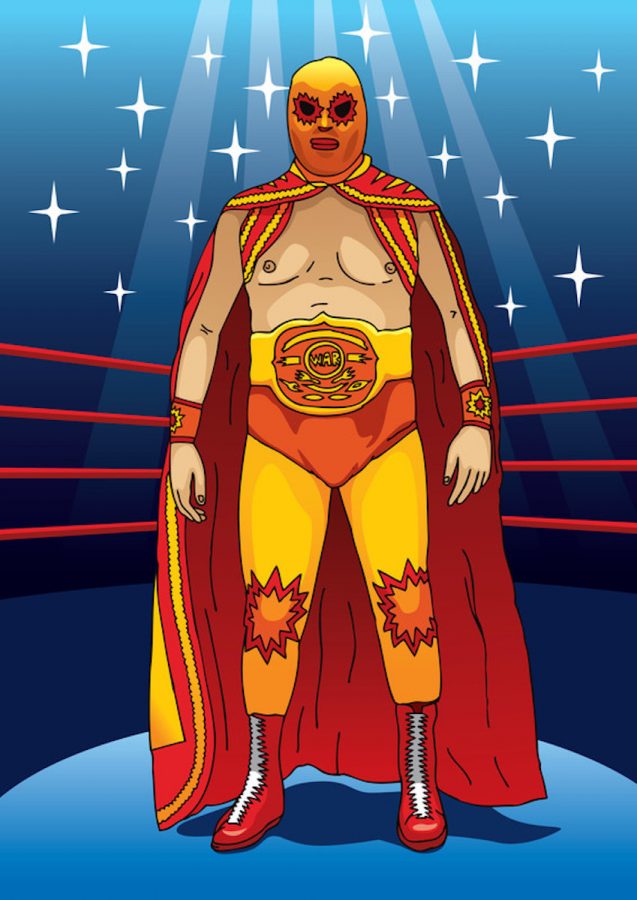Vigor in the Valley
What’s up with pro wrestling?
Photo by Can Stock Photography
Professional wrestling premiered in the United States in the late 1860s after the Civil War, according to Pro Wrestling Stories.com. Wrestlers often competed at carnivals, where audience members could place bets on the wrestlers.
I’ll be the first to admit I don’t know everything, especially when it comes to calculus or anything to do with plumbing. Last Sunday, I found one more subject I know next to nothing about: professional wrestling.
I was talking with Shayne Holtzman, a journalism student at UW-Eau Claire, about pro wrestling. As I listened to him talk about the sport, I realized I have a lot to learn about wrestling. So, I asked Holtzman a few questions about his passion.
How long have you been wrestling?
“I have been involved in the sport of wrestling since I was 11 years old. I wrestled from 2007 to 2012 in folk style. I did a total of six seasons, winning a conference championship for Menomonie High School in 2012 at 132 pounds.”
How (and when) did you get into pro wrestling?
“I started getting into professional wrestling as a fan when I was 11 years old in 2007. I have been watching World Wrestling Entertainment (WWE) as an avid fan since then. I began my training in professional wrestling in September of 2014 for an independent promotion known as Brew City Wrestling in West Allis, Wis. I, unfortunately, was not able to complete my training due to having to move back home to Menomonie.”
Why is there a draw to wrestling, and why do athletes continue even though the sport is mentally and physically tough?
“The draw to wrestling, I believe, mostly comes from passion and love for the sport. When I was competing in middle and high school, I couldn’t stay away from it. I just loved the adrenaline rush I’d gain from being on the mat, and the feeling of self-confidence I’d gain after winning a tough match. The sport itself, where it does have a team aspect to it with dual meets, is also very individualistic. Meaning, it is you on that mat, it is you who makes the decisions that lead to you winning or losing — a wrestler can’t blame anybody if they lose their match. It teaches, in a sense, accountability.
When it comes to professional wrestling it once again comes down to passion, but more a passion to entertain, because that is what professional wrestling is. It’s entertainment when someone is the business. They aren’t there to be a tough guy, they are there to entertain the fans, and give them the best experience possible.”
How can someone get involved in pro wrestling?
“If someone were wanting to get involved in professional wrestling, there are actual schools where one can train in the business, as well as one can train in the independent circuit, which is like the minor leagues of wrestling. Once they have finished their training then what would be best is to travel the world wrestling wherever you can and learning. One would need to be a sponge and must listen especially if they want to find success in this tough business.”
Where is the best place to find pro wrestling?
“The best place is on your television, where WWE airs its programming every week on Monday and Tuesday nights. There are also multiple independent promotions around the country where tickets are relatively cheap, so live shows are even possible.”
Is wrestling accessible to everyone?
“Wrestling is absolutely accessible to all. With the access to the Internet and streaming services, it has become and will continue to become more accessible.”
What are the biggest misconceptions about the sport?
“That the sport is completely fake. Yes, there is some staging aspects to it, but that is entirely for the purpose to entertain, also what they do in the ring is always a risk. If those in the ring competing are not in full trust of each other, then overall it will become more dangerous and someone will get hurt.”
Neupert can be reached at neupercm7411@uwec.edu.

Neupert is a fourth-year journalism student at UW-Eau Claire. She is the executive producer of Engage Eau Claire on Blugold Radio Sunday. In her spare time, Neupert's working on becoming a crossword puzzle expert.


